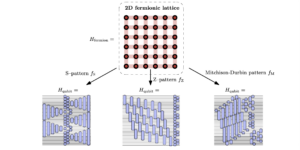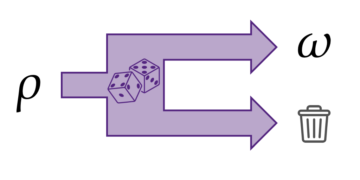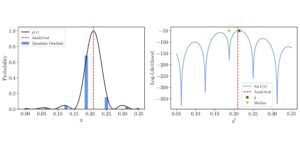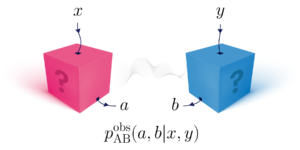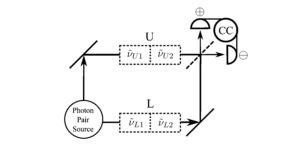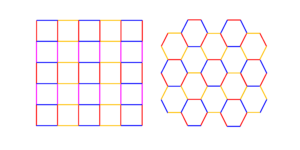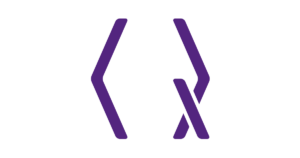1Institute for Quantum Computing, University of Waterloo, Waterloo, Ontario N2L 3G1, Canada
2Department of Physics and Astronomy, University of Waterloo, Waterloo, Ontario N2L 3G1, Canada
3Computation-based Science and Technology Research Center,The Cyprus Institute, 20 Kavafi Street, 2121 Nicosia, Cyprus
4Institute of Theoretical Physics and IQST, Universität Ulm, Albert-Einstein-Allee 11, D-89069 Ulm, Germany
5Department of Electrical and Computer Engineering, University of Waterloo, Waterloo, Ontario N2L 3G1, Canada
6NIC, DESY Zeuthen, Platanenallee 6, 15738 Zeuthen, Germany
7Perimeter Institute for Theoretical Physics, Waterloo, Ontario N2L 2Y5, Canada
Find this paper interesting or want to discuss? Scite or leave a comment on SciRate.
Abstract
Quantum-enhanced computing methods are promising candidates to solve currently intractable problems. We consider here a variational quantum eigensolver (VQE), that delegates costly state preparations and measurements to quantum hardware, while classical optimization techniques guide the quantum hardware to create a desired target state. In this work, we propose a bosonic VQE using superconducting microwave cavities, overcoming the typical restriction of a small Hilbert space when the VQE is qubit based. The considered platform allows for strong nonlinearities between photon modes, which are highly customisable and can be tuned in situ, i.e. during running experiments. Our proposal hence allows for the realization of a wide range of bosonic ansatz states, and is therefore especially useful when simulating models involving degrees of freedom that cannot be simply mapped to qubits, such as gauge theories, that include components which require infinite-dimensional Hilbert spaces. We thus propose to experimentally apply this bosonic VQE to the U(1) Higgs model including a topological term, which in general introduces a sign problem in the model, making it intractable with conventional Monte Carlo methods.
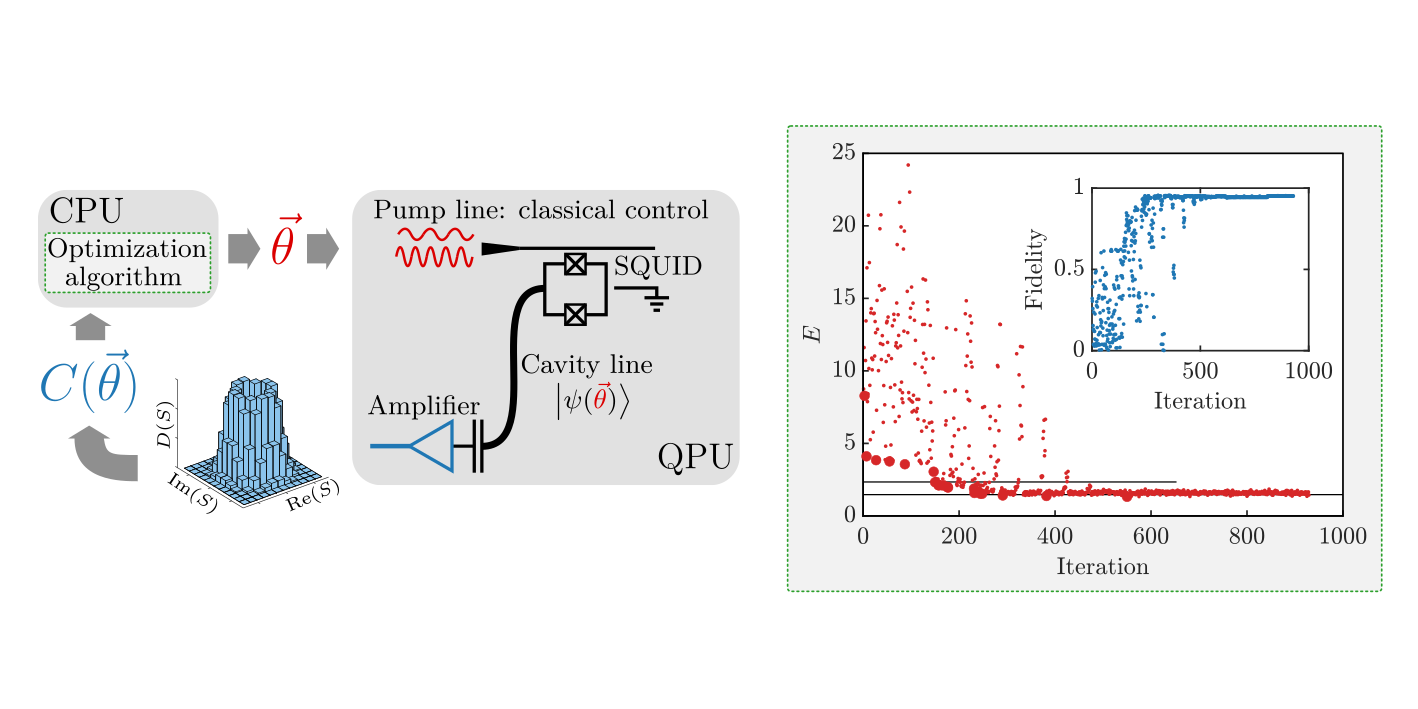
Popular summary
In this work, we propose to use photons in superconducting microwave cavities as a new quantum platform to study gauge theories. While many quantum computing platforms are based on qubits, which have two available states, the photons in a microwave cavity are a higher-dimensional system that can be exploited for the computation. This is particularly relevant because bosonic fields have intrinsically high-dimensional elements, and recent technological developments offer us an excellent level of control and variety of interactions between the microwave photons.
The theory we choose to study is called a U(1) Higgs model with a topological term. This theory contains rich and emblematic physics that we simulate via a hybrid quantum-classical algorithm called a variational quantum eigensolver (VQE). This protocol uses the quantum platform, in our case the microwave cavity, to perform evaluations that are classically hard, and a classical computer to perform a variational optimization that is robust to errors. We show that a VQE is able to compute the lowest-energy state of the model for a range of parameters, allowing us to study different phases of the system that have qualitatively different behaviour.
We discuss in detail and show that the quantum algorithm we developed is experimentally accessible, it studies a gauge theory that would not be accessible with classical methods alone, and it opens up many new possibilities to further develop quantum simulations for gauge theories.
► BibTeX data
► References
[1] E. Farhi, J. Goldstone, and S. Gutmann. “A quantum approximate optimization algorithm” (2014). arXiv:1411.4028.
arXiv:1411.4028
[2] J. R. McClean, J. Romero, R. Babbush, and A. Aspuru-Guzik. “The theory of variational hybrid quantum-classical algorithms”. New J. Phys. 18, 023023 (2016).
https://doi.org/10.1088/1367-2630/18/2/023023
[3] J. Preskill. “Quantum Computing in the NISQ era and beyond”. Quantum 2, 79 (2018).
https://doi.org/10.22331/q-2018-08-06-79
[4] M. Cerezo, A. Arrasmith, R. Babbush, S. C. Benjamin, S. Endo, K. Fujii, J. R. McClean, K. Mitarai, X. Yuan, L. Cincio, and P. J. Coles. “Variational quantum algorithms”. Nat. Rev. Phys. 3, 625–644 (2021).
https://doi.org/10.1038/s42254-021-00348-9
[5] C. Muschik, M. Heyl, E. Martinez, T. Monz, P. Schindler, B. Vogell, Marcello Dalmonte, P. Hauke, R. Blatt, and P. Zoller. “U(1) Wilson lattice gauge theories in digital quantum simulators”. New J. Phys. 19, 103020 (2017).
https://doi.org/10.1088/1367-2630/aa89ab
[6] A. Kandala, A. Mezzacapo, K. Temme, M. Takita, M. Brink, J. M. Chow, and J. M. Gambetta. “Hardware-efficient variational quantum eigensolver for small molecules and quantum magnets”. Nature 549, 242 (2017).
https://doi.org/10.1038/nature23879
[7] C. Kokail, C. Maier, R. van Bijnen, T. Brydges, M. K. Joshi, P. Jurcevic, C. A. Muschik, P. Silvi, R. Blatt, C. F. Roos, and P. Zoller. “Self-verifying variational quantum simulation of lattice models”. Nature 569, 355–360 (2019).
https://doi.org/10.1038/s41586-019-1177-4
[8] N. Klco, E. F. Dumitrescu, A. J. McCaskey, T. D. Morris, R. C. Pooser, M. Sanz, E. Solano, P. Lougovski, and M. J. Savage. “Quantum-classical computation of schwinger model dynamics using quantum computers”. Phys. Rev. A 98, 032331 (2018).
https://doi.org/10.1103/PhysRevA.98.032331
[9] A. Mezzacapo, E. Rico, C. Sabín, I. Egusquiza, L. Lamata, and E. Solano. “Non-Abelian SU(2) Lattice Gauge Theories in Superconducting Circuits”. Phys. Rev. Lett. 115, 240502 (2015).
https://doi.org/10.1103/PhysRevLett.115.240502
[10] B. Yang, H. Sun, R. Ott, H.-Y. Wang, T. V. Zache, J. C. Halimeh, Z.-S. Yuan, P. Hauke, and J.-W. Pan. “Observation of gauge invariance in a 71-site Bose–Hubbard quantum simulator”. Nature 587, 392–396 (2020).
https://doi.org/10.1038/s41586-020-2910-8
[11] N. Klco, M. J. Savage, and J. R. Stryker. “SU(2) non-Abelian gauge field theory in one dimension on digital quantum computers”. Phys. Rev. D 101, 074512 (2020).
https://doi.org/10.1103/PhysRevD.101.074512
[12] Y. Y. Atas, J. Zhang, R. Lewis, A. Jahanpour, J. F. Haase, and C. A. Muschik. “SU(2) hadrons on a quantum computer via a variational approach”. Nat. Commun. 12, 6499 (2021).
https://doi.org/10.1038/s41467-021-26825-4
[13] L. Lumia, P. Torta, G. B. Mbeng, G. E. Santoro, E. Ercolessi, M. Burrello, and M. M. Wauters. “Two-Dimensional $mathbb{Z}_{2}$ Lattice Gauge Theory on a Near-Term Quantum Simulator: Variational Quantum Optimization, Confinement, and Topological Order”. PRX Quantum 3, 020320 (2022).
https://doi.org/10.1103/PRXQuantum.3.020320
[14] Z.-Y. Zhou, G.-X. Su, J. C. Halimeh, R. Ott, H. Sun, P. Hauke, B. Yang, Z.-S. Yuan, J. Berges, and J.-W. Pan. “Thermalization dynamics of a gauge theory on a quantum simulator”. Science 377, 311–314 (2022).
https://doi.org/10.1126/science.abl6277
[15] C. W. S. Chang, M. Simoen, J. Aumentado, C. Sabín, P. Forn-Díaz, A. M. Vadiraj, F. Quijandría, G. Johansson, I. Fuentes, and C. M. Wilson. “Generating Multimode Entangled Microwaves with a Superconducting Parametric Cavity”. Phys. Rev. App. 10, 044019 (2018).
https://doi.org/10.1103/PhysRevApplied.10.044019
[16] H. Alaeian, C. W. S. Chang, M. V. Moghaddam, C. M. Wilson, E. Solano, and E. Rico. “Creating lattice gauge potentials in circuit QED: The bosonic Creutz ladder”. Phys. Rev. A 99, 053834 (2019).
https://doi.org/10.1103/PhysRevA.99.053834
[17] C. W. S. Chang, C. Sabín, P. Forn-Díaz, F. Quijandría, A. M. Vadiraj, I. Nsanzineza, G. Johansson, and C. M. Wilson. “Observation of Three-Photon Spontaneous Parametric Down-Conversion in a Superconducting Parametric Cavity”. Phys. Rev. X 10, 011011 (2020).
https://doi.org/10.1103/PhysRevX.10.011011
[18] J. S. Hung, J. H. Busnaina, C. S. Chang, A. Vadiraj, I. Nsanzineza, E. Solano, H. Alaeian, E. Rico, and C. Wilson. “Quantum Simulation of the Bosonic Creutz Ladder with a Parametric Cavity”. Phys. Rev. Lett. 127, 100503 (2021).
https://doi.org/10.1103/PhysRevLett.127.100503
[19] A. Vrajitoarea, Z. Huang, P. Groszkowski, J. Koch, and A. A. Houck. “Quantum control of an oscillator using a stimulated Josephson nonlinearity”. Nat. Phys. 16, 211–217 (2020).
https://doi.org/10.1038/s41567-019-0703-5
[20] T. Sulejmanpasic and C. Gattringer. “Abelian gauge theories on the lattice: $theta$-Terms and compact gauge theory with(out) monopoles”. Nucl. Phys. B 943, 114616 (2019).
https://doi.org/10.1016/j.nuclphysb.2019.114616
[21] C. Gattringer, D. Göschl, and T. Sulejmanpašić. “Dual simulation of the 2d U(1) gauge Higgs model at topological angle $theta = pi$: Critical endpoint behavior”. Nucl. Phys. B 935, 344–364 (2018).
https://doi.org/10.1016/j.nuclphysb.2018.08.017
[22] D. Göschl, C. Gattringer, and T. Sulejmanpasic. “The critical endpoint in the 2-d U(1) gauge-Higgs model at topological angle $theta=pi$”. PoS LATTICE2018, 226 (2018).
https://doi.org/10.22323/1.334.0226
[23] S. Dar. “The Neutron EDM in the SM : A Review” (2000). arXiv:hep-ph/0008248.
arXiv:hep-ph/0008248
[24] M. Pospelov and A. Ritz. “Electric dipole moments as probes of new physics”. Ann. Phys. 318, 119 (2005).
https://doi.org/10.1016/j.aop.2005.04.002
[25] A. G. Cohen, D. Kaplan, and A. Nelson. “Progress in electroweak baryogenesis”. Ann. Rev. Nucl. Part. Sci. 43, 27–70 (1993).
https://doi.org/10.1146/annurev.ns.43.120193.000331
[26] I. Ichinose and T. Matsui. “Lattice gauge theory for condensed matter physics: ferromagnetic superconductivity as its example”. Mod. Phys. Lett. B 28, 1430012 (2014).
https://doi.org/10.1142/s0217984914300129
[27] Z. Komargodski, A. Sharon, R. Thorngren, and X. Zhou. “Comments on Abelian Higgs models and persistent order”. SciPost Phys. 6, 3 (2019).
https://doi.org/10.21468/SciPostPhys.6.1.003
[28] S. Coleman. “More about the massive Schwinger model”. Annals of Physics 101, 239–267 (1976).
https://doi.org/10.1016/0003-4916(76)90280-3
[29] C. Adam. “Massive schwinger model within mass perturbation theory”. Ann. Phys. 259, 1 – 63 (1997).
https://doi.org/10.1006/aphy.1997.5697
[30] T. M. R. Byrnes, P. Sriganesh, R. J. Bursill, and C. J. Hamer. “Density matrix renormalization group approach to the massive schwinger model”. Phys. Rev. D 66, 013002 (2002).
https://doi.org/10.1103/PhysRevD.66.013002
[31] B. Buyens, S. Montangero, J. Haegeman, F. Verstraete, and K. Van Acoleyen. “Finite-representation approximation of lattice gauge theories at the continuum limit with tensor networks”. Phys. Rev. D 95, 094509 (2017).
https://doi.org/10.1103/PhysRevD.95.094509
[32] T. V. Zache, N. Mueller, J. T. Schneider, F. Jendrzejewski, J. Berges, and P. Hauke. “Dynamical topological transitions in the massive schwinger model with a ${theta}$ term”. Phys. Rev. Lett. 122, 050403 (2019).
https://doi.org/10.1103/PhysRevLett.122.050403
[33] L. Funcke, K. Jansen, and S. Kühn. “Topological vacuum structure of the schwinger model with matrix product states”. Phys. Rev. D 101, 054507 (2020).
https://doi.org/10.1103/PhysRevD.101.054507
[34] M. Anosova, C. Gattringer, D. Göschl, T. Sulejmanpasic, and P. Törek. “Topological terms in abelian lattice field theories”. PoS LATTICE2019, 082 (2019).
https://doi.org/10.22323/1.363.0082
[35] D. Göschl. “Dual simulation of the massless lattice schwinger model with topological term and non-zero chemical potential”. EPJ Web Conf. 175, 07002 (2018).
https://doi.org/10.1051/epjconf/201817507002
[36] A. Kan, L. Funcke, S. Kühn, L. Dellantonio, J. Zhang, J. F. Haase, C. A. Muschik, and K. Jansen. “Investigating a $(3+1)mathrm{D}$ topological $theta$-term in the Hamiltonian formulation of lattice gauge theories for quantum and classical simulations”. Phys. Rev. D 104, 034504 (2021).
https://doi.org/10.1103/PhysRevD.104.034504
[37] E. Fradkin and S. H. Shenker. “Phase diagrams of lattice gauge theories with Higgs fields”. Phys. Rev. D 19, 3682 (1979).
https://doi.org/10.1103/physrevd.19.3682
[38] D. R. T. Jones, J. Kogut, and D. K. Sinclair. “Electrodynamics of the planar model: Its phase diagram, continuum limit, and mass spectrum”. Phys. Rev. D 19, 1882–1905 (1979).
https://doi.org/10.1103/physrevd.19.1882
[39] D. González-Cuadra, E. Zohar, and J. I. Cirac. “Quantum simulation of the Abelian-Higgs lattice gauge theory with ultracold atoms”. New J. Phys. 19, 063038 (2017).
https://doi.org/10.1088/1367-2630/aa6f37
[40] F. Verstraete, V. Murg, and J. Cirac. “Matrix product states, projected entangled pair states, and variational renormalization group methods for quantum spin systems”. Adv. Phys. 57, 143–224 (2008).
https://doi.org/10.1080/14789940801912366
[41] U. Schollwöck. “The density-matrix renormalization group in the age of matrix product states”. Ann. Phys. 326, 96 (2011).
https://doi.org/10.1016/j.aop.2010.09.012
[42] R. Orús. “A practical introduction to tensor networks: Matrix product states and projected entangled pair states”. Ann. Phys. 349, 117 – 158 (2014).
https://doi.org/10.1016/j.aop.2014.06.013
[43] S. Coleman. “The Uses of Instantons”. In A. Zichichi, editor, The Whys of Subnuclear Physics. Pages 805–941. The Subnuclear Series. Springer US, Boston, MA (1979).
https://doi.org/10.1007/978-1-4684-0991-8_16
[44] C. J. Hamer, Z. Weihong, and J. Oitmaa. “Series expansions for the massive schwinger model in hamiltonian lattice theory”. Phys. Rev. D 56, 55–67 (1997).
https://doi.org/10.1103/PhysRevD.56.55
[45] M. C. Bañuls, K. Cichy, K. Jansen, and J. I. Cirac. “The mass spectrum of the schwinger model with matrix product states”. J. High Energy Phys. 2013, 158 (2013).
https://doi.org/10.1007/JHEP11(2013)158
[46] E. A. Martinez, C. A. Muschik, P. Schindler, D. Nigg, A. Erhard, M. Heyl, P. Hauke, M. Dalmonte, T. Monz, P. Zoller, and R. Blatt. “Real-time dynamics of lattice gauge theories with a few-qubit quantum computer”. Nature 534, 516–519 (2016).
https://doi.org/10.1038/nature18318
[47] G. Wendin. “Quantum information processing with superconducting circuits: a review”. Rep. Prog. Phys. 80, 106001 (2017).
https://doi.org/10.1088/1361-6633/aa7e1a
[48] P. Krantz, M. Kjaergaard, F. Yan, T. P. Orlando, S. Gustavsson, and W. D. Oliver. “A quantum engineer’s guide to superconducting qubits”. App. Phys. Rev. 6, 021318 (2019).
https://doi.org/10.1063/1.5089550
[49] A. Blais, A. L. Grimsmo, S. M. Girvin, and A. Wallraff. “Circuit quantum electrodynamics”. Rev. Mod. Phys. 93, 025005 (2021).
https://doi.org/10.1103/RevModPhys.93.025005
[50] D. Paulson, L. Dellantonio, J. F. Haase, A. Celi, A. Kan, A. Jena, C. Kokail, R. van Bijnen, K. Jansen, P. Zoller, and C. A. Muschik. “Simulating 2D Effects in Lattice Gauge Theories on a Quantum Computer”. PRX Quantum 2, 030334 (2021).
https://doi.org/10.1103/PRXQuantum.2.030334
[51] C. W. S. Chang. “Two-photon and three-photon parametric interactions in superconducting microwave circuits”. PhD thesis. University of Waterloo. (2019). url: http://hdl.handle.net/10012/14892.
http://hdl.handle.net/10012/14892
[52] N. Frattini, U. Vool, S. Shankar, A. Narla, K. Sliwa, and M. Devoret. “3-wave mixing Josephson dipole element”. App. Phys. Lett. 110, 222603 (2017).
https://doi.org/10.1063/1.4984142
[53] E. Knill, R. Laflamme, and G. J. Milburn. “A scheme for efficient quantum computation with linear optics”. Nature 409, 46–52 (2001).
https://doi.org/10.1038/35051009
[54] P. Kok, W. J. Munro, K. Nemoto, T. C. Ralph, J. P. Dowling, and G. J. Milburn. “Linear optical quantum computing with photonic qubits”. Rev. Mod. Phys. 79, 135–174 (2007).
https://doi.org/10.1103/RevModPhys.79.135
[55] I. Bloch, J. Dalibard, and S. Nascimbene. “Quantum simulations with ultracold quantum gases”. Nat. Phys. 8, 267–276 (2012).
https://doi.org/10.1038/nphys2259
[56] A. A. Houck, H. E. Türeci, and J. Koch. “On-chip quantum simulation with superconducting circuits”. Nat. Phys. 8, 292–299 (2012).
https://doi.org/10.1038/nphys2251
[57] E. Zohar and B. Reznik. “Confinement and Lattice Quantum-Electrodynamic Electric Flux Tubes Simulated with Ultracold Atoms”. Phys. Rev. Lett. 107, 275301 (2011).
https://doi.org/10.1103/PhysRevLett.107.275301
[58] D. Yang, G. S. Giri, M. Johanning, C. Wunderlich, P. Zoller, and P. Hauke. “Analog quantum simulation of $(1+1)$-dimensional lattice qed with trapped ions”. Phys. Rev. A 94, 052321 (2016).
https://doi.org/10.1103/PhysRevA.94.052321
[59] R. Ott, T. Zache, F. Jendrzejewski, and J. Berges. “Scalable Cold-Atom Quantum Simulator for Two-Dimensional QED”. Phys. Rev. Lett. 127, 130504 (2021).
https://doi.org/10.1103/PhysRevLett.127.130504
[60] A. Grimm, N. Frattini, S. Puri, S. Mundhada, S. Touzard, M. Mirrahimi, S. Girvin, S. Shankar, and M. Devoret. “Stabilization and operation of a kerr-cat qubit”. Nature 584, 205–209 (2020).
https://doi.org/10.1038/s41586-020-2587-z
[61] W.-L. Chow. “über systeme von linearen partiellen differential-gleichungen erster ordnung”. Math. Ann. 117, 98 (1940).
https://doi.org/10.1142/9789812776921_0005
[62] G. M. Huang, T. J. Tarn, and J. W. Clark. “On the controllability of quantum-mechanical systems”. J. Math. Phys. 24, 2608–2618 (1983).
https://doi.org/10.1063/1.525634
[63] J. M. Gambetta, J. M. Chow, and M. Steffen. “Building logical qubits in a superconducting quantum computing system”. Npj Quantum Inf. 3, 1–7 (2017).
https://doi.org/10.1038/s41534-016-0004-0
[64] C. S. Wang, J. C. Curtis, B. J. Lester, Y. Zhang, Y. Y. Gao, J. Freeze, V. S. Batista, P. H. Vaccaro, I. L. Chuang, L. Frunzio, L. Jiang, S. M. Girvin, and R. J. Schoelkopf. “Efficient multiphoton sampling of molecular vibronic spectra on a superconducting bosonic processor”. Phys. Rev. X 10, 021060 (2020).
https://doi.org/10.1103/PhysRevX.10.021060
[65] M. Esposito, A. Ranadive, L. Planat, and N. Roch. “Perspective on traveling wave microwave parametric amplifiers”. Appl. Phys. Lett. 119, 120501 (2021).
https://doi.org/10.1063/5.0064892
[66] M. P. da Silva, D. Bozyigit, A. Wallraff, and A. Blais. “Schemes for the observation of photon correlation functions in circuit QED with linear detectors”. Phys. Rev. A 82, 043804 (2010).
https://doi.org/10.1103/PhysRevA.82.043804
[67] C. Eichler, D. Bozyigit, and A. Wallraff. “Characterizing quantum microwave radiation and its entanglement with superconducting qubits using linear detectors”. Phys. Rev. A 86, 032106 (2012).
https://doi.org/10.1103/PhysRevA.86.032106
[68] Z. Chen, J. Kelly, C. Quintana, R. Barends, B. Campbell, Y. Chen, B. Chiaro, A. Dunsworth, A. G. Fowler, E. Lucero, E. Jeffrey, A. Megrant, J. Mutus, M. Neeley, C. Neill, P. J. J. O’Malley, P. Roushan, D. Sank, A. Vainsencher, J. Wenner, T. C. White, A. N. Korotkov, and J. M. Martinis. “Measuring and suppressing quantum state leakage in a superconducting qubit”. Phys. Rev. Lett. 116, 020501 (2016).
https://doi.org/10.1103/PhysRevLett.116.020501
[69] M. Kjaergaard, M. E. Schwartz, J. Braumüller, P. Krantz, J. I.-J. Wang, S. Gustavsson, and W. D. Oliver. “Superconducting Qubits: Current State of Play”. Annual Review of Condensed Matter Physics 11, 369–395 (2020).
https://doi.org/10.1146/annurev-conmatphys-031119-050605
[70] L. Acerbi and W. Ji. “Practical bayesian optimization for model fitting with bayesian adaptive direct search”. In I. Guyon, U. V. Luxburg, S. Bengio, H. Wallach, R. Fergus, S. Vishwanathan, and R. Garnett, editors, Advances in Neural Information Processing Systems 30. Pages 1836–1846. Curran Associates, Inc. (2017).
[71] C. Audet and J. E. Dennis. “Mesh adaptive direct search algorithms for constrained optimization”. SIAM J. Optim. 17, 188–217 (2006).
https://doi.org/10.1137/040603371
[72] P. I. Frazier. “A tutorial on bayesian optimization” (2018). arXiv:1807.02811.
arXiv:1807.02811
[73] J. Heitger. “Numerical simulations of gauge-Higgs models on the lattice”. PhD thesis. Westfälische Wilhelms-Universität Münster. (1997). url: https://www.uni-muenster.de/Physik.TP/archive/fileadmin/Arbeiten/heitger_dr.pdf.
https://www.uni-muenster.de/Physik.TP/archive/fileadmin/Arbeiten/heitger_dr.pdf
[74] T. Sulejmanpasic, D. Göschl, and C. Gattringer. “First-principles simulations of $1+1mathrm{D}$ quantum field theories at ${theta}={pi}$ and spin chains”. Phys. Rev. Lett. 125, 201602 (2020).
https://doi.org/10.1103/PhysRevLett.125.201602
[75] F. Verstraete, D. Porras, and J. I. Cirac. “Density matrix renormalization group and periodic boundary conditions: A quantum information perspective”. Phys. Rev. Lett. 93, 227205 (2004).
https://doi.org/10.1103/PhysRevLett.93.227205
[76] M. C. Bañuls, K. Cichy, J. I. Cirac, K. Jansen, and S. Kühn. “Density induced phase transitions in the schwinger model: A study with matrix product states”. Phys. Rev. Lett. 118, 071601 (2017).
https://doi.org/10.1103/PhysRevLett.118.071601
[77] P. Sala, T. Shi, S. Kühn, M. C. Bañuls, E. Demler, and J. I. Cirac. “Variational study of u(1) and su(2) lattice gauge theories with gaussian states in 1+1 dimensions”. Phys. Rev. D 98, 034505 (2018).
https://doi.org/10.1103/PhysRevD.98.034505
[78] M. C. Bañuls and K. Cichy. “Review on novel methods for lattice gauge theories”. Rep. Prog. Phys. 83, 024401 (2020).
https://doi.org/10.1088/1361-6633/ab6311
[79] D. González-Cuadra, T. V. Zache, J. Carrasco, B. Kraus, and P. Zoller. “Hardware Efficient Quantum Simulation of Non-Abelian Gauge Theories with Qudits on Rydberg Platforms”. Phys. Rev. Lett. 129, 160501 (2022).
https://doi.org/10.1103/PhysRevLett.129.160501
[80] A. Ciavarella, N. Klco, and M. J. Savage. “Trailhead for quantum simulation of SU(3) Yang-Mills lattice gauge theory in the local multiplet basis”. Phys. Rev. D 103, 094501 (2021).
https://doi.org/10.1103/PhysRevD.103.094501
[81] J. F. Haase, L. Dellantonio, A. Celi, D. Paulson, A. Kan, K. Jansen, and C. A. Muschik. “A resource efficient approach for quantum and classical simulations of gauge theories in particle physics”. Quantum 5, 393 (2021).
https://doi.org/10.22331/q-2021-02-04-393
[82] M. C. Bañuls, R. Blatt, J. Catani, A. Celi, J. I. Cirac, M. Dalmonte, L. Fallani, K. Jansen, M. Lewenstein, S. Montangero, C. A. Muschik, B. Reznik, E. Rico, L. Tagliacozzo, K. Van Acoleyen, F. Verstraete, U.-J. Wiese, M. Wingate, J. Zakrzewski, and P. Zoller. “Simulating lattice gauge theories within quantum technologies”. The European Physical Journal D 74, 165 (2020).
https://doi.org/10.1140/epjd/e2020-100571-8
[83] E. Zohar. “Quantum simulation of lattice gauge theories in more than one space dimension—requirements, challenges and methods”. Philos. trans., Math. phys. eng. sci. 380, 20210069 (2021).
https://doi.org/10.1098/rsta.2021.0069
[84] V. Kasper, G. Juzeliūnas, M. Lewenstein, F. Jendrzejewski, and E. Zohar. “From the Jaynes–Cummings model to non-abelian gauge theories: A guided tour for the quantum engineer”. New Journal of Physics 22, 103027 (2020).
https://doi.org/10.1088/1367-2630/abb961
[85] H. Riechert, J. C. Halimeh, V. Kasper, L. Bretheau, E. Zohar, P. Hauke, and F. Jendrzejewski. “Engineering a U(1) lattice gauge theory in classical electric circuits”. Phys. Rev. B 105, 205141 (2022).
https://doi.org/10.1103/PhysRevB.105.205141
[86] Y. Kuno, S. Sakane, K. Kasamatsu, I. Ichinose, and T. Matsui. “Quantum simulation of ($1+1$)-dimensional U(1) gauge-Higgs model on a lattice by cold Bose gases”. Phys. Rev. D 95, 094507 (2017).
https://doi.org/10.1103/PhysRevD.95.094507
[87] A. Peruzzo, J. McClean, P. Shadbolt, M.-H. Yung, X.-Q. Zhou, P. J. Love, A. Aspuru-Guzik, and J. L. O’Brien. “A variational eigenvalue solver on a photonic quantum processor”. Nat. Commun. 5, 1 (2014).
https://doi.org/10.1038/ncomms5213
Cited by
[1] Christian W. Bauer, Zohreh Davoudi, A. Baha Balantekin, Tanmoy Bhattacharya, Marcela Carena, Wibe A. de Jong, Patrick Draper, Aida El-Khadra, Nate Gemelke, Masanori Hanada, Dmitri Kharzeev, Henry Lamm, Ying-Ying Li, Junyu Liu, Mikhail Lukin, Yannick Meurice, Christopher Monroe, Benjamin Nachman, Guido Pagano, John Preskill, Enrico Rinaldi, Alessandro Roggero, David I. Santiago, Martin J. Savage, Irfan Siddiqi, George Siopsis, David Van Zanten, Nathan Wiebe, Yukari Yamauchi, Kübra Yeter-Aydeniz, and Silvia Zorzetti, “Quantum Simulation for High-Energy Physics”, PRX Quantum 4 2, 027001 (2023).
[2] He-Liang Huang, Xiao-Yue Xu, Chu Guo, Guojing Tian, Shi-Jie Wei, Xiaoming Sun, Wan-Su Bao, and Gui-Lu Long, “Near-term quantum computing techniques: Variational quantum algorithms, error mitigation, circuit compilation, benchmarking and classical simulation”, Science China Physics, Mechanics, and Astronomy 66 5, 250302 (2023).
[3] Roland C. Farrell, Ivan A. Chernyshev, Sarah J. M. Powell, Nikita A. Zemlevskiy, Marc Illa, and Martin J. Savage, “Preparations for quantum simulations of quantum chromodynamics in 1 +1 dimensions. I. Axial gauge”, Physical Review D 107 5, 054512 (2023).
[4] Roland C. Farrell, Ivan A. Chernyshev, Sarah J. M. Powell, Nikita A. Zemlevskiy, Marc Illa, and Martin J. Savage, “Preparations for quantum simulations of quantum chromodynamics in 1 +1 dimensions. II. Single-baryon β -decay in real time”, Physical Review D 107 5, 054513 (2023).
[5] Anthony N. Ciavarella and Ivan A. Chernyshev, “Preparation of the SU(3) lattice Yang-Mills vacuum with variational quantum methods”, Physical Review D 105 7, 074504 (2022).
[6] Zohreh Davoudi, Alexander F. Shaw, and Jesse R. Stryker, “General quantum algorithms for Hamiltonian simulation with applications to a non-Abelian lattice gauge theory”, arXiv:2212.14030, (2022).
[7] A. Kan, L. Funcke, S. Kühn, L. Dellantonio, J. Zhang, J. F. Haase, C. A. Muschik, and K. Jansen, “3+1D theta-Term on the Lattice from the Hamiltonian Perspective”, The 38th International Symposium on Lattice Field Theory 112 (2022).
[8] G. Iannelli and K. Jansen, “Noisy Bayesian optimization for variational quantum eigensolvers”, The 38th International Symposium on Lattice Field Theory 251 (2022).
[9] Anthony N. Ciavarella, Stephan Caspar, Marc Illa, and Martin J. Savage, “State Preparation in the Heisenberg Model through Adiabatic Spiraling”, Quantum 7, 970 (2023).
[10] Judah F. Unmuth-Yockey, “Metropolis-style random sampling of quantum gates for the estimation of low-energy observables”, Physical Review D 105 3, 034515 (2022).
[11] Anthony N. Ciavarella, Stephan Caspar, Hersh Singh, and Martin J. Savage, “Preparation for quantum simulation of the (1 +1 ) -dimensional O(3) nonlinear σ model using cold atoms”, Physical Review A 107 4, 042404 (2023).
[12] Yiming Ding, Xiaopeng Cui, and Yu Shi, “Digital quantum simulation and pseudoquantum simulation of the Z<SUB>2</SUB> gauge-Higgs model”, Physical Review D 105 5, 054508 (2022).
The above citations are from SAO/NASA ADS (last updated successfully 2023-10-23 16:19:49). The list may be incomplete as not all publishers provide suitable and complete citation data.
Could not fetch Crossref cited-by data during last attempt 2023-10-23 16:19:47: Could not fetch cited-by data for 10.22331/q-2023-10-23-1148 from Crossref. This is normal if the DOI was registered recently.
This Paper is published in Quantum under the Creative Commons Attribution 4.0 International (CC BY 4.0) license. Copyright remains with the original copyright holders such as the authors or their institutions.
- SEO Powered Content & PR Distribution. Get Amplified Today.
- PlatoData.Network Vertical Generative Ai. Empower Yourself. Access Here.
- PlatoAiStream. Web3 Intelligence. Knowledge Amplified. Access Here.
- PlatoESG. Carbon, CleanTech, Energy, Environment, Solar, Waste Management. Access Here.
- PlatoHealth. Biotech and Clinical Trials Intelligence. Access Here.
- Source: https://quantum-journal.org/papers/q-2023-10-23-1148/
- :is
- :not
- ][p
- $UP
- 003
- 06
- 08
- 09
- 1
- 10
- 11
- 116
- 118
- 12
- 125
- 13
- 14
- 15%
- 16
- 17
- 19
- 20
- 2000
- 2001
- 2005
- 2006
- 2008
- 2011
- 2012
- 2013
- 2014
- 2015
- 2016
- 2017
- 2018
- 2019
- 2020
- 2021
- 2022
- 2023
- 22
- 23
- 24
- 25
- 26%
- 27
- 28
- 29
- 2D
- 30
- 31
- 32
- 33
- 35%
- 36
- 39
- 40
- 41
- 49
- 50
- 51
- 54
- 58
- 60
- 66
- 67
- 7
- 70
- 72
- 75
- 77
- 8
- 80
- 84
- 87
- 9
- 970
- 98
- a
- Able
- About
- above
- ABSTRACT
- access
- accessible
- acquire
- Adam
- adaptive
- advances
- affiliations
- age
- Alexander
- algorithm
- algorithms
- All
- Allowing
- allows
- alone
- an
- and
- announced
- annual
- Anthony
- app
- applications
- Apply
- approach
- approximate
- ARE
- AS
- astronomy
- At
- attempt
- author
- authors
- available
- based
- basis
- Bayesian
- BE
- because
- been
- behavior
- benchmarking
- Benjamin
- BEST
- between
- Beyond
- boston
- boundary
- Break
- brink
- by
- called
- CAN
- candidates
- cannot
- case
- Center
- chains
- challenges
- chang
- chemical
- chen
- China
- Choose
- chow
- Christine
- Christopher
- cohen
- cold
- comment
- Commons
- compact
- complete
- components
- computation
- Compute
- computer
- Computer Engineering
- computers
- computing
- Condensed matter
- conditions
- CONFIRMED
- Consider
- considered
- constitute
- contains
- Continuum
- control
- conventional
- copyright
- Correlation
- costly
- could
- create
- critical
- Current
- Current state
- Currently
- customisable
- Cyprus
- da
- data
- Date
- David
- delegates
- description
- desired
- detail
- develop
- developed
- developments
- diagrams
- different
- digital
- Dimension
- dimensions
- direct
- discovery
- discuss
- do
- draper
- during
- dynamics
- e
- editor
- editors
- effects
- efficient
- Electric
- element
- elements
- Endpoint
- energy
- engineer
- Engineering
- entanglement
- Era
- error
- Errors
- especially
- European
- evaluations
- example
- excellent
- Except
- exciting
- experiments
- Explains
- exploited
- far
- fergus
- field
- Fields
- fitting
- FLUX
- For
- Foundation
- Freedom
- Freeze
- from
- functions
- fundamental
- further
- GAO
- Gates
- gauge
- General
- George
- gravity
- Group
- guide
- guided
- handle
- Hard
- Hardware
- harvard
- Have
- hence
- henry
- here
- High
- highly
- holders
- How
- http
- HTTPS
- huang
- hung
- Hybrid
- hybrid quantum-classical
- i
- if
- ii
- in
- Inc.
- include
- Including
- information
- Institute
- institutions
- interactions
- interesting
- International
- intrinsically
- Introduces
- Introduction
- involving
- IT
- ITS
- ivan
- Jan
- JavaScript
- jeffrey
- John
- jones
- Joshi
- journal
- karl
- Koch
- ladder
- Last
- Leave
- Level
- Lewis
- Li
- License
- LIMIT
- List
- local
- logical
- Long
- love
- Magnets
- Maier
- Making
- many
- Martin
- Mass
- masses
- massive
- math
- Matrix
- Matter
- max-width
- May..
- mcclean
- measurements
- mechanics
- mechanism
- methods
- mikhail
- mitigation
- Mixing
- model
- models
- Modern
- modes
- molecular
- Moments
- Month
- more
- multiphoton
- Nature
- networks
- neural
- New
- normal
- novel
- observation
- Oct
- of
- offer
- oliver
- on
- ONE
- Ontario
- open
- opens
- operation
- Opportunity
- optics
- optimization
- or
- order
- original
- Orlando
- our
- out
- overcoming
- pages
- pair
- Paper
- parameters
- part
- particular
- particularly
- patrick
- Perform
- periodic
- perspective
- phase
- phd
- Photons
- physical
- Physics
- platform
- Platforms
- plato
- Plato Data Intelligence
- PlatoData
- Play
- PoS
- possibilities
- potential
- potentials
- Powell
- Practical
- preparation
- Problem
- problems
- processing
- Processor
- Product
- projected
- prominent
- promising
- proposal
- propose
- protocol
- provide
- published
- publisher
- publishers
- Quantum
- quantum algorithms
- Quantum Computer
- quantum computers
- quantum computing
- quantum information
- Qubit
- qubits
- R
- random
- range
- real
- real-time
- realization
- recent
- recently
- references
- registered
- relevant
- remains
- require
- research
- resource
- restriction
- review
- Rich
- RICO
- robust
- Roland
- running
- Ryan
- s
- scheme
- SCI
- Science
- Science and Technology
- Search
- Series
- show
- siam
- sign
- silva
- silvia
- simply
- simulation
- simulator
- small
- So
- so Far
- SOLVE
- Space
- spaces
- Spectrum
- Spin
- standard
- State
- States
- stefan
- street
- strong
- structure
- studies
- Study
- success
- Successfully
- such
- suitable
- Sun
- superconducting
- Superconductivity
- Symposium
- system
- Systems
- Target
- techniques
- technological
- Technologies
- Technology
- term
- terms
- than
- that
- The
- their
- Them
- theoretical
- theory
- therefore
- thesis
- they
- this
- Through
- Thus
- time
- Title
- to
- Tour
- transitions
- Traveling
- tutorial
- two
- typical
- under
- understand
- university
- updated
- URL
- us
- use
- uses
- using
- Vacuum
- variety
- via
- volume
- von
- W
- want
- was
- Wave
- we
- web
- What
- when
- which
- while
- white
- wide
- Wide range
- Wilson
- with
- within
- Work
- would
- X
- year
- Yuan
- zephyrnet



